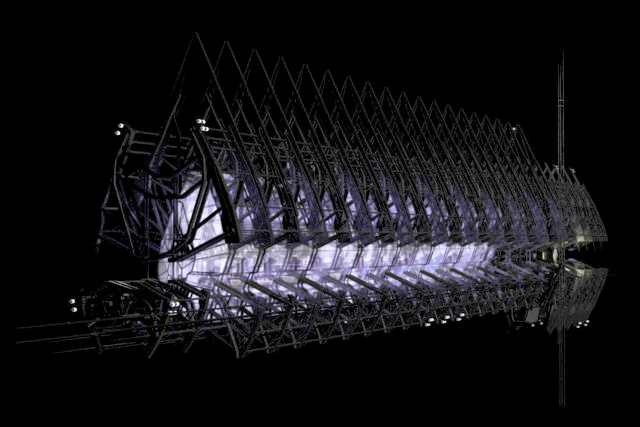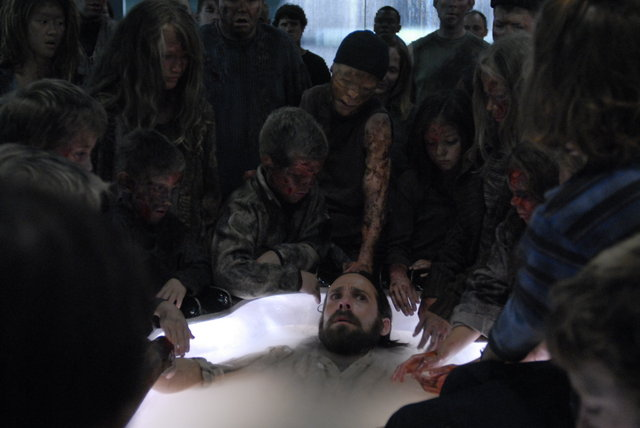Exogenesis: Mind Children and Cultured Images in Battlestar Galactica

In “The Work of Art in the Age of Biocybernetic Reproduction,” W.J.T. Mitchell claims that we live in an era where biocybernetic technologies such as cloning, genetic engineering, and artificial intelligence have actually made possible the uncanny fantasy of “the double” come to life.1 At the same time, we are dominated by another form of reproductive technology: visual media and the mass reproduction of images.
The convergence of these two strands of reproductive technologies is ghosted by that seminal text of popular imagination, Mary Shelley’s Frankenstein. The monster of that novel, so often conflated with its creator, initiates a series of fantasies that cross breed with scientific facts around the phenomena of ectogenesis: reproduction outside of the human body. Ectogenesis ranges from the existing technology of invitro (literally “in glass”) fertilization (and, interestingly, the first test tube baby, Louise Brown, was born in 1978, the same year that the original Battlestar Galactica debuted), to as yet science fictional fantasies of gestation, often of mass produced copies, such as the current Battlestar Galactica’s Cylon reproduction, by which dead Cylons resurrect after downloading into new, fully grown bodies in vast vats of goo. From Shelley’s novel onwards, fantasies of ectogenesis have been accompanied by the drive to make visible what has remained hidden: to render the body, and thus knowledge, transparent (or invisible, in the erasure of the mother’s body from the spectacle of reproduction). As relatively routine examples, we see this in the promise of genetic testing to reveal a child’s future or through visual representations of fetal life such as ultrasounds. As a more fantastic televisual example, in season three of Battlestar Galactica, we see the Cylon Three’s serial suicides, motivated by the hope that, if she can just keep her eyes open long enough while being reborn, she will gain a prophetic and complete knowledge of the faces of the “final five.” Her ecstatic knowledge, though, results less in clarity than obscurity: punished for her epistemophilia, her model is now “boxed” and out of view.

Of course, the Cylons, for all that they participate in the visual tradition of ectogenesis, are not human offspring merely grown outside the womb. Instead, they are what Artificial Intelligence researcher Hans Moravec has termed “mind children” — the constructed offspring of human mental labor — and like ectogenesis, which divorces humans from birth as the traditional process of entering into the family and the human community at large, mind children hopelessly problematize the question of origins.2 Here, we witness the slide from ectogenesis to exogenesis (meaning “outside origin”). Sometimes used to refer to the theory that life on earth originated elsewhere in the universe, the proximate homonym of exo and ecto straddles a gap that echoes that of the human/Cylon relation. The continuing suspense around identifying the Cylon (for both humans and Cylons with the “Final Five”) marks a failure of recognition, undoing the ability to recognize not only the other but, more insistently, the self. Nowhere was this made more evident than the slow dawning of self-recognition in the episode “Crossroads II” as Tigh, Tyrol, Anders, and Tory recite the lyrics of a remade version of the popular song “All Along the Watchtower,” their own bodies having become mediums of reception and ambivalent repetition.
Where did they Cylons come from? Originally, these mind children were “toasters” (objects), visibly different from their human creators; but the missing link between the toasters and the “skin jobs” has remained a mystery thus far. What is disturbing is how these mind children have come to resemble the human in bodily form. The exogenesis of the Cylons enacts confusion between mind and body, between spirit and corporeality, between content and expression. As Brian Rotman writes, “A principal mode of exogenesis is synthetic assemblage, the coming (or putting) together of independent activities to form a new, functionally unified, and autonomous entity with emergent properties not present in its components” (436).3 In other words, Cylons are more than the sum of their parts, exposing the failure of origin as explanatory model.
Made, not born, and then reborn outside of the body, the Cylons manifest an interior made exterior and visible, but also a failed transparency that calls attention to the vital force of images themselves. What results from making the internal activity of human reproduction visible is not an inverted relation between interior and exterior, but a topological uncertainty between the two. A topological relation is one of connection and movement; the Cylons are an example of this as a networked society, but the humans are also subject to this topological sense of the self. Returning to Shelley’s Frankenstein to explain this, while, in the novel, the monster’s birth is a clear example of ectogenesis, this birth is doubled by another origin. In her introduction, Shelley writes: “When I placed my head on my pillow, I did not sleep, nor could I be said to think. My imagination, unbidden, possessed and guided me, gifting the successive images that arose in my mind with a vividness far beyond the usual bounds of reverie” (8-9).4 That she would proceed to write a drama of reproductive technology is no surprise, and Battlestar Galactica has extended this theme by explicitly linking the reproductive imaginary force of the Cylons to another form of making the interior visible: the proliferation of hallucinations and the externalization of memory amongst humans and Cylons alike. The Cylons are thus also connected to a different form of exogenesis explicitly linked to visions, yoking the reproductive technologies of biology and media through the play of hallucination, prophecy, and vision. Just as the Cylons render the humans into unwilling nomads by destroying the colonies, so too they have made their own sense of self into a nomadic one. That which we might think of as the most personal experiences of an interior subjectivity — memories, imagination, fantasy — emerge into the environment beyond the boundaries of the corporeal self.

Indeed, their ability to project an inner state onto the world around them is a key element of Cylon psychology. As Caprica Six describes it to Baltar in “Torn”: “where you see a ship, I see a beautiful forest.” This immersive relation to the world is what individuates the Cylons, rather than being distinguished visibly from each other by an individual body. They project a subjective experience of the world onto their externalized surroundings, weaving a lived world out of a fabricated fantasy. The precise nature of the mechanism is as yet unclear. Nevertheless, this suggests a relation to the environment that does not stop at the skin and that addresses an incorporeal dimension of the body — that is, if the Cylons are a form of extended mind, we should necessarily see that as a form of extended body as well.
The relation between Baltar and Caprica Six is a key example that exists at the nexus of these logics of reproduction, in which reproduction moves away from being an originary event to an ongoing negotiation with the world. Baltar has a “virtual Six,” and more recently, Six has been shown to have her own “virtual Baltar”: the question of what exactly they are has remains active. As viewers, we have a doubled vision of these encounters as well, both from the point of view of Baltar and Six and from the often-hilarious perspective of an outside onlooker wondering what exactly these two are up to. That so much of this “virtual interaction” has centered on question of identity (Baltar repeatedly asks if he is a Cylon, while Six is accused by virtual Baltar of wanting to be human) but also around the question of reproduction, in which Baltar and Six imagine themselves as Hera’s true parents, makes the link between these two types of reproductive technologies explicit.
But the destabilizing effects of the Cylons are not limited to the boundaries between human and Cylon; they have bled over into the everyday experience of the humans themselves. In other words, like the Baltar/Six relation, we also have a host of other “mixed reality” experiences that signal the topological landscape of interior/exterior, public/private, actual/virtual indistinctions that characterize the series. For example, President Roslin was subject to a series of hallucinations in the first season of the show when, diagnosed with terminal cancer, she began taking the hallucinogenic herb chamalla as a treatment of last resort. Roslin’s visions bled over into diegetic “reality” in several ways, not only finding echoes in sacred texts, but in the indistinction between physical and mental disease that her condition implies. It is fascinating that she was only (temporarily) “stabilized” by an infusion of the blood of the hybrid child Hera. This clarity is tenuous at best, as Roslin is now (ambiguously) part Cylon.

Other human characters have likewise been subject to visions: Tigh is haunted by glimpses of his murdered wife, a constant catching her out of the corner of the eye that is the paranoid legacy of the multiple copies of the Cylons themselves. In “A Day in the Life,” we see William Adama constructing a “memory palace,” a mnemonic technique that is supposed to assure mastery of memory by calling all the experiences of life to hand. Once again, though, there is a shifting topology: when Adama externalizes what we normally think of as internal — our memories — as he seeks to recall the names of his crew by locating them in objects in his garden, we see him existing within the memory itself, a shifting geography both spatially and temporally. In a later scene with Roslin, he addresses himself equally to the present (speaking to Roslin), the past (speaking to his wife), and in many respects to the future as well. There is an intimate and vivid reality to his interaction with what seems to be the memory of his wife that is framed by repetition and images — he seeks to contain and locate the memory in the framed photo of his wedding day and in the anniversary, but the temporal repetition of “that date” undoes his efforts. There are many copies, and each copy carries the force of exogenesis or outside origin.
While Shelley’s book asks us to rethink the nature of the human when confronted with its anthropomorphic other, Battlestar Galactica is moving beyond ectogenesis to exogenesis and extending the question to the “incorporeal nature” of the human body itself through models of distributed cognition, extended body, memory, and the virtual reality of images. As such, the Cylons are not simply mind children, but themselves are a kind of cultured image, a term that suggests the uncanny vitality and inhuman liveliness at the heart of our image culture. The Cylons have at best an ambiguous relation to their so-called creators. The humans do not occupy the place of god, and it is this black box of origin (in the non-committal repetition of “they evolved”) — the displacement of the origin, or what Gilles Deleuze might call the “faithlessness of the bad copy” — that inspires a vertiginous relation to the self that marks the indistinction between biological reproductive technologies and the media.5 The Cylons, mind children of the human, are at the same time cultured images: images in the sense that there are multiple copies, but also images that are cultured, as in a Petri dish, imbued with a disturbing liveliness beyond any analogy or resemblance to the humans they visually echo. Cylons as such gestate invitro, within the glass of the TV screen: not test tube babies but boob tube babies. As the made, the Cylons displace the idea of original in favor of a model of creative evolution, of which the humans are absolutely a part. What happened in the gap so inadequately filled at the beginning of each episode by “they evolved”? This seems less important and interesting than the ways in which, as cultured images, Cylons both evoke and exceed biological and media technological reproduction alike, a viral infectious non-human form of reproduction — there are many copies.
Author Bio:
Alanna Thain is an assistant professor of cultural studies in the department of English at McGill University in Montreal. Currently, her research focuses on questions of affect, expanded bodies and distributed cognition in the intersections between dance and audiovisual images in the works of William Kentridge, Norman McLaren, Marie Chouinard, David Lynch and others.
Image Credits:
1. Cylon Resurrection Ship
2. Three resurrects, screencap provided by author.
3. Six and Three in their “projected” environment, ibid.
4. Gaius’s nightmare of resurrection, ibid.
Please feel free to comment.
- W.J.T. Mitchell, “The Work of Art in the Age of Biocybernetic Reproduction,” Modernism / Modernity. 10.3 (Sept. 2003). 481-501. [↩]
- Hans Moravec, Mind Children, Cambridge: Harvard UP, 1990. [↩]
- Brian Rotman, “Corporeal or Gesturo-haptic Writing,” Configurations 10.3 (Fall 2002), 423-38. [↩]
- Mary Shelley, Frankenstein, New York: Penguin, 1992. [↩]
- Gilles Deleuze, Difference and Repetition, trans. Paul Patton, New York: Columbia UP, 1994. [↩]
Pingback: FlowTV | Battlestardom: Conversations with Mary McDonnell
Pingback: FlowTV | Television Conceptions: Introduction to “Re/Producing Cult TV: The Battlestar Galactica Issue”